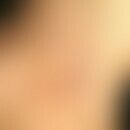Synonym(s)
Hereditary benign intraepithelial dyskeratosis; OMIM 127600; Red-eye syndrome; Witkop-Sallmann syndrome; Witkop-von-Sallmann syndrome
HistoryThis section has been translated automatically.
von Sallmann 1959; Witkop 1960
DefinitionThis section has been translated automatically.
Rare intraepithelial dyskeratosis of the oral mucosa or the eye.
You might also be interested in
Occurrence/EpidemiologyThis section has been translated automatically.
Originally only described in Haliwa Indians and their descendants (North Carolina, USA). In the last few years also sporadically appeared in other parts of the USA and Europe.
EtiopathogenesisThis section has been translated automatically.
Autosomal-dominantly inherited mutations (duplications) of the HBID gene (hereditary benign intraepithelial dyskeratosis gene) located on chromosome 4q35
ClinicThis section has been translated automatically.
Exacerbation mostly in spring, normalization of the findings mostly in late summer/autumn.
- Integument: Soft, white, spongy deposits and wrinkles of the oral mucosa on cheeks, lips, floor of the mouth, underside and side edges of the tongue, less on the gums and palate. Easily scraped surface coverings, no seasonal dependence. Clinical picture of the oral mucosa very similar to the white mucosal nevus.
- Eyes: Gelatinous whitish deposits of the perilimbic conjunctiva bulbi with conjunctival injection, blepharospasm and photophobia (especially in children). Sometimes also pterygium-like changes of the conjunctiva.
HistologyThis section has been translated automatically.
Epithelium of the oral mucosa widened with large vacuolated cells in the stratum spinosum containing dyskeratotic cells
TherapyThis section has been translated automatically.
Ophthalmologic and dental treatment is in the foreground.
LiteratureThis section has been translated automatically.
- Allingham RR et al (2001) A duplication in chromosome 4q35 is associated with hereditary benign intraepithelial dyskeratosis. At J Hum Genet 68: 491-494
- Haisley-Royster CA et al (2001) Hereditary benign intraepithelial dyskeratosis: Report of two cases with prominent oral lesions. J Am Acad Dermatol 45: 634-636
- Mc Lean IW, Riddle PJ, Scruggs JH, Jones DB (1981) Hereditary benign intraepithelial dyskeratosis. Report of two cases from Texas. Ophthalmol 88: 164-168
- Sadeghi EM, Witkop CJ (1977) Ultrastructural study of hereditary benign intraepithelial dyskeratosis. Oral surgeries 44: 567.
- by Sallmann L, Paton D (1959) Hereditary dyskeratosis of the perilimbal conjunctiva. Transact Am Ophthalmol Soc 57: 53-60
- by Sallmann L, Paton D (1960) Hereditary benign intraepithelial dyskeratosis. Ocular manifestations. Arch. Ophthal. 63: 421-429
- Witkop CJ et al (1960) Hereditary benign intraepithelial dyskeratosis. II Oral manifestations and hereditary transmission. Arch Catholic 70: 696-711
Disclaimer
Please ask your physician for a reliable diagnosis. This website is only meant as a reference.




